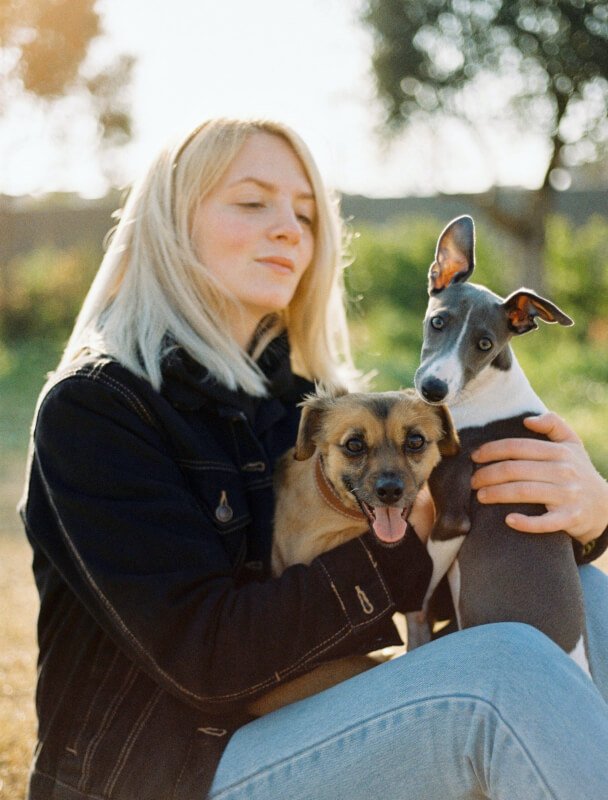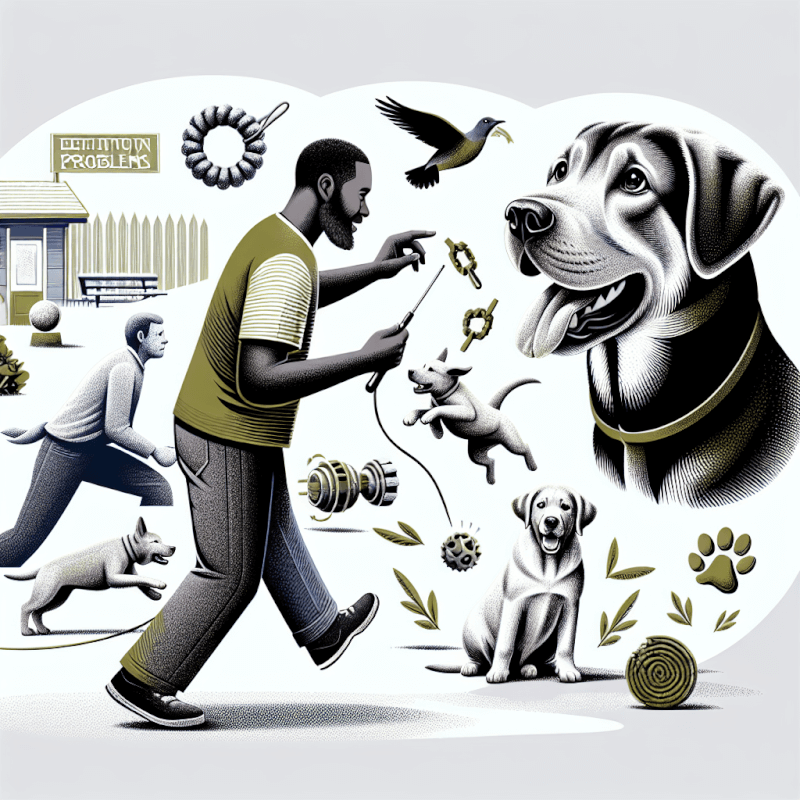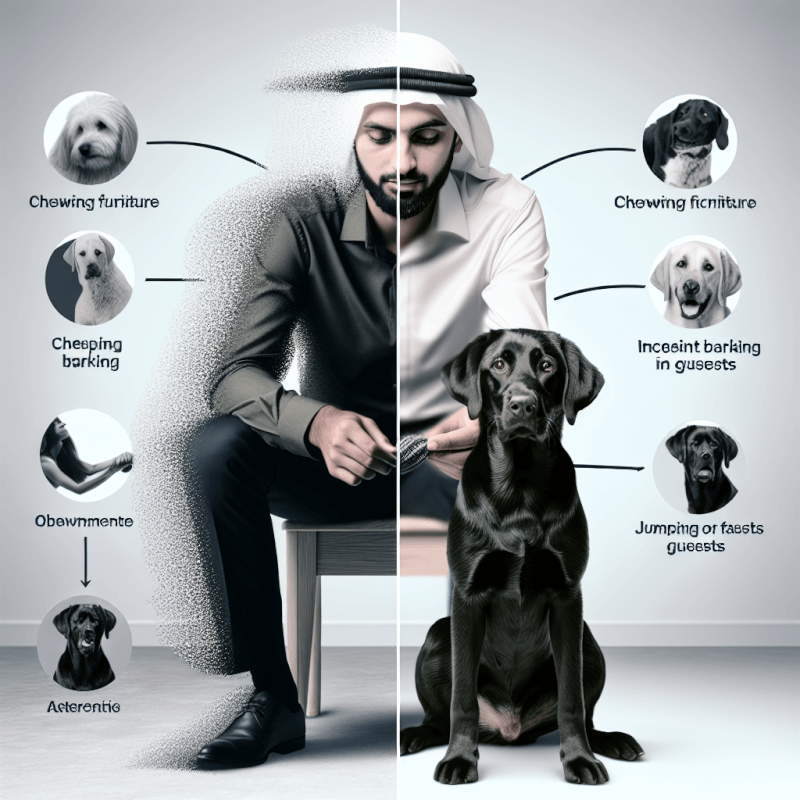Are you struggling with your furry friend’s behavior problems? Look no further! This article provides you with the essential guide to dog training for behavior problems. Whether it’s excessive barking, aggression, or separation anxiety, we’ve got you covered. Discover effective techniques and tips that will help you address and overcome your dog’s behavior issues. Get ready to create a harmonious and well-behaved canine companion with our expert advice. Let’s embark on this journey together and transform your dog’s behavior for the better!
Understanding Dog Behavior Problems
Common dog behavior problems
Dog behavior problems can include a variety of issues that can be frustrating and challenging for both pet owners and their furry friends. Some common behavior problems that dogs may exhibit include aggression towards humans or other dogs, separation anxiety, excessive barking, chewing and destructive behavior, jumping on people, digging up the garden, and pulling on the leash.
Ready for Cat Trivia?
Test your knowledge about cats!

Causes of dog behavior problems
Dog behavior problems can arise from a variety of factors. It is important to understand that dogs are highly influenced by their environment and experiences. Some of the common causes of behavior problems in dogs include lack of proper socialization during the critical early development period, fear or anxiety, inconsistent training or discipline, past traumatic experiences, boredom or lack of mental stimulation, and medical issues that may be contributing to the behavior problems.
The importance of addressing behavior problems
Addressing dog behavior problems is not only important for the well-being of your canine companion, but also for the safety and happiness of your household. Behavior problems can escalate if left unaddressed and may lead to potential injuries, damage to property, and strained relationships with family, friends, and neighbors. By understanding and addressing these problems, you can help your dog to become a well-behaved and balanced member of your family.
Choosing the Right Training Techniques
Positive reinforcement
Positive reinforcement is a training technique that focuses on rewarding desired behaviors rather than punishing unwanted behaviors. This approach involves using treats, praise, and affection to reinforce behaviors that you want your dog to repeat. By rewarding your dog for good behavior, such as sitting on command or walking calmly on a leash, you are encouraging them to continue exhibiting those behaviors.
Negative reinforcement
Negative reinforcement involves removing an unpleasant stimulus when your dog displays the desired behavior. This can be done by releasing pressure on a training collar when your dog responds to a command or by stopping an annoying noise when they exhibit the desired behavior. By using negative reinforcement correctly, you can teach your dog to associate certain behaviors with the removal of an unpleasant stimulus, which can be an effective training technique.
Clicker training
Clicker training is a form of positive reinforcement that uses a small handheld device, known as a clicker, to mark desired behaviors. The clicker emits a distinct noise, which is immediately followed by a reward such as a treat or praise. By associating the clicker sound with a positive outcome, your dog will quickly learn to understand and repeat the behaviors that elicit the clicker reward.
Using rewards and treats
Using rewards and treats is a highly effective training technique, as most dogs are motivated by food. By providing treats as rewards for desired behaviors, your dog will associate those behaviors with positive outcomes and will be more likely to repeat them. It is important to choose appropriate treats that are small in size and high in value to maintain your dog’s interest and motivation during training sessions.
Voice commands and hand signals
In addition to using rewards and treats, dogs can also be trained using voice commands and hand signals. By using consistent and clear verbal cues, such as “sit” or “stay,” along with corresponding hand signals, you can effectively communicate your expectations to your dog. This combination of verbal and visual cues allows for clear communication and enhances your dog’s understanding of the desired behavior.

Identifying Specific Behavior Problems
Aggression towards humans
Aggression towards humans is a serious behavior problem that should be addressed immediately. It can manifest in various forms, including growling, lunging, or biting. The underlying causes of aggression towards humans can be fear, anxiety, lack of socialization, past traumatic experiences, or possessiveness. Seeking the help of a professional dog trainer or behaviorist is crucial in addressing this issue and ensuring the safety of both your dog and those around them.
Aggression towards other dogs
Aggression towards other dogs can arise from a variety of reasons, such as fear, dominance, resource guarding, or lack of socialization. It is important to assess the triggers that elicit the aggressive behavior and to work on desensitization and behavior modification techniques. Gradual exposure to other dogs under controlled circumstances and proper training can help to reduce or eliminate aggressive behaviors towards other dogs.
Separation anxiety
Separation anxiety is a common behavior problem in dogs and can result in destructive behavior, excessive barking, and attempts to escape. Dogs with separation anxiety often become anxious or distressed when left alone, leading to behaviors such as whining, pacing, or destructive chewing. Gradual desensitization and counterconditioning techniques can be used to help dogs overcome separation anxiety. Creating a safe and comfortable space, providing mental stimulation, and establishing a consistent routine can also help alleviate their anxiety.
Excessive barking
Excessive barking can be a nuisance for both dog owners and neighbors. Dogs may bark excessively due to boredom, fear, alarm, territorial instincts, attention-seeking, or separation anxiety. Identifying the underlying cause of the excessive barking is crucial in addressing this behavior problem. Teaching the ‘quiet’ command, distraction techniques, and using positive reinforcement to reward calm behavior can help reduce excessive barking. Consistency and patience are key in modifying this behavior.
Chewing and destructive behavior
Chewing and destructive behavior are natural behaviors for dogs, but they can become problematic when directed towards inappropriate objects or areas. Dogs may chew and destroy furniture, shoes, or household items due to boredom, anxiety, teething, or lack of appropriate chew toys. Providing appropriate chew toys, using bitter taste deterrents on items you don’t want your dog to chew, and crate training are effective strategies for preventing destructive chewing. It is also important to provide mental and physical stimulation to keep your dog entertained and satisfied.
Jumping on people
Jumping on people is a common behavior problem that can be both annoying and potentially dangerous. Dogs may jump on people as a way of greeting or seeking attention. To address this behavior, it is important to ignore and turn away from your dog when they jump, redirect their behavior with commands such as “sit” or “off,” and teach them sit and stay commands as an alternative behavior. Consistent management of greetings and maintaining a calm and controlled environment are key to curbing jumping behavior.
Digging up the garden
Digging up the garden can be frustrating for dog owners who take pride in their outdoor spaces. Dogs may dig due to boredom, instinctual behavior, seeking cool spots, or searching for buried treasures. To prevent or redirect digging behavior, it is important to provide alternative outlets for digging, such as a designated digging area or sandbox. Distracting your dog with toys or games, providing plenty of exercise, and supervising your dog when outside can also help reduce unwanted digging behavior.
Pulling on the leash
Pulling on the leash is a common behavior problem that can make walks unpleasant and difficult. Dogs may pull on the leash due to excitement, lack of training, or a desire to explore their surroundings. To teach proper leash walking, it is important to choose the right leash and collar/harness that provides control without causing discomfort. Reward-based leash training, teaching loose leash walking, using cues and commands, and practicing consistently can help train your dog to walk calmly on a leash.
Addressing Aggression Problems
Seeking professional help
Dealing with aggression problems requires professional guidance and expertise. Aggression can be a complex issue with serious implications and potential risks. It is advisable to seek the help of a professional dog trainer or behaviorist who specializes in aggression problems. They can assess your dog’s behavior, identify triggers, and develop a behavior modification plan tailored to your dog’s specific needs.
Understanding the triggers
Understanding the triggers that elicit aggressive behavior is crucial in addressing aggression problems. Triggers can include specific situations, objects, or interactions that cause fear, anxiety, or frustration for your dog. By identifying and understanding these triggers, you can work on desensitization techniques and gradually expose your dog to the triggers in a controlled and positive manner.
Socialization and desensitization
Socialization and desensitization are important techniques for addressing aggression problems. Proper socialization during the critical early development period is essential for dogs to learn appropriate behavior towards other dogs, humans, and various environments. Desensitization involves exposing your dog to the triggers that elicit aggressive behavior in a controlled and gradual manner, allowing them to learn new, positive associations with those triggers.
Implementing behavior conditioning techniques
Behavior conditioning techniques, such as counterconditioning and systematic desensitization, can be used to modify aggressive behaviors. Counterconditioning involves pairing the presence of a trigger that elicits aggressive behavior with something positive, such as treats or praise, to change your dog’s emotional response. Systematic desensitization involves gradually exposing your dog to the trigger at a level where they do not display aggression, and progressively increasing the intensity or proximity over time.
Creating a calm and structured environment
Creating a calm and structured environment is essential for addressing aggression problems and promoting positive behavior. Providing clear rules, boundaries, and consistent routines can help your dog feel secure and reduce anxiety or stress that may contribute to aggressive behaviors. Leadership exercises, such as obedience training and reinforcing positive behaviors, can also establish you as the pack leader and help your dog feel more secure in their role within the family.

Dealing with Separation Anxiety
Gradual desensitization
Gradual desensitization is a technique that can be effective in helping dogs with separation anxiety. It involves slowly and systematically exposing your dog to short periods of time alone, gradually increasing the duration over time. This technique helps your dog become more comfortable with being alone and reduces their anxiety and distress. It is important to start with very short periods and ensure that your dog remains calm and relaxed throughout the process.
Creating a safe and comfortable space
Creating a safe and comfortable space for your dog when they are left alone can help alleviate their separation anxiety. This can be achieved by providing a designated area, such as a crate or a specific room, where your dog feels secure. Equipping the area with comfortable bedding, familiar scents, and engaging toys can help distract and entertain your dog during your absence.
Environmental enrichment
Providing environmental enrichment can help stimulate your dog’s mind and alleviate separation anxiety. This can include puzzle toys, interactive feeders, or treat-dispensing toys that keep your dog mentally engaged and occupied. Leaving calming music or white noise in the background can also help create a soothing and comforting environment for your dog.
Establishing a consistent routine
Establishing a consistent routine is important for dogs with separation anxiety, as it helps them predict and anticipate what will happen next. A consistent routine provides a sense of security and reduces anxiety. Try to establish a daily schedule for walks, meals, playtime, and alone time, and stick to it as closely as possible.
Providing mental stimulation
Providing mental stimulation is essential for dogs with separation anxiety, as it helps keep their minds occupied and reduces boredom and anxiety. This can include interactive toys, puzzle games, or training sessions. Mental stimulation allows your dog to focus their energy on positive activities and helps distract them from their anxiety.
Effectively Reducing Excessive Barking
Identifying the underlying cause
Identifying the underlying cause of excessive barking is crucial in effectively reducing this behavior. Dogs may bark excessively due to boredom, fear, alarm, territorial instincts, attention-seeking, or separation anxiety. By understanding the cause, you can implement appropriate strategies to address the specific issue.
Teaching the ‘quiet’ command
Teaching your dog the ‘quiet’ command can be a useful tool in reducing excessive barking. Start by rewarding moments of silence and associate the command with the desired behavior. Gradually increase the duration of quiet behavior before providing the reward. Consistency and repetition are key in teaching this command.
Distraction techniques
Distraction techniques can be effective in redirecting your dog’s attention away from barking triggers. Providing interactive toys, engaging in play sessions, or offering treats can help divert their focus and interrupt the barking behavior. By offering an alternative activity, you can encourage your dog to engage in more desirable behaviors.
Using positive reinforcement to reward calm behavior
Using positive reinforcement to reward calm behavior is an effective way to reduce excessive barking. When your dog remains calm and quiet in situations that usually trigger barking, provide immediate praise, treats, or affection. This reinforces the desired behavior and helps your dog associate calmness with positive outcomes.
Consistency and patience
Consistency and patience are key when trying to reduce excessive barking. It is important to be consistent in your training approach, expectations, and reactions to barking behavior. Avoid yelling or punishment, as this can increase anxiety and escalate the barking. With time and consistent training efforts, you can help your dog develop more appropriate and controlled vocalization habits.

Preventing Destructive Chewing
Providing appropriate chew toys
Providing appropriate chew toys is essential in preventing destructive chewing behavior. Dogs have a natural instinct to chew, especially during their teething phase. By offering a variety of safe and durable chew toys, you can redirect your dog’s chewing behavior onto appropriate items. Choose toys that are suitable for your dog’s size, age, and chewing style to ensure their safety.
Using bitter taste deterrents
Bitter taste deterrents can be applied to objects or areas that you want to discourage your dog from chewing. These deterrents have a bitter taste that is unpleasant to dogs, discouraging them from chewing on those items. Be sure to choose a product that is safe, non-toxic, and specifically formulated for use on dogs.
Crate training
Crate training can be an effective method to prevent destructive chewing when you are unable to supervise your dog. A crate provides a safe and confined space where your dog can relax and feel secure. By properly introducing and acclimating your dog to the crate, they will view it as their den and be less likely to engage in destructive chewing when confined.
Interrupting and redirecting chewing behavior
When you catch your dog engaging in inappropriate chewing behavior, it is important to interrupt the behavior promptly. Do not punish or scold your dog, as this may create fear or anxiety. Instead, redirect their attention to an appropriate chew toy and provide praise or treats when they chew on that item. Consistency and reinforcement of appropriate chewing behaviors will help modify their behavior over time.
Supervision and confinement
Proper supervision and confinement are important in preventing destructive chewing. When you cannot directly supervise your dog, confining them to a safe and dog-proofed area, such as a crate or gated room, can help prevent access to items they may be tempted to chew. Gradually increase their freedom and access to other areas of the house as they consistently demonstrate appropriate chewing behaviors.
Teaching Proper Leash Walking
Choosing the right leash and collar/harness
Choosing the right leash and collar or harness is important for teaching proper leash walking. There are various types of leashes and collars/harnesses available, including flat collars, choke chains, prong collars, and front-clip harnesses. It is essential to select a tool that is safe, comfortable, and appropriate for your dog’s size and breed. A front-clip harness or a gentle leader headcollar can provide more control and discourage pulling.
Reward-based leash training
Reward-based leash training involves using positive reinforcement to reward your dog for desired behaviors while on the leash. By rewarding your dog with treats, praise, or play when they walk calmly by your side or respond to cues, you can reinforce those behaviors. Be consistent with rewards and gradually increase the duration and distractions during training sessions.
Teaching loose leash walking
Teaching loose leash walking involves training your dog to walk without pulling or tension on the leash. Start by rewarding your dog for walking near you with a loose leash, using treats or verbal praise. If your dog starts to pull or move ahead, stop walking and wait for them to relax and return to your side before continuing. Repeat this process consistently to reinforce the desired behavior.
Using cues and commands
Using cues and commands can help communicate your expectations to your dog during leash walking. Simple commands such as “heel” or “let’s go” can be used to signal to your dog that they should walk by your side. Consistently use these commands during training sessions and reward your dog when they respond correctly.
Consistency and practice
Consistency and practice are essential in teaching proper leash walking. Set aside dedicated training sessions to work on leash walking skills, gradually increasing the difficulty as your dog becomes more proficient. Practice in different environments and around distractions to ensure that your dog can maintain loose leash walking behavior in various situations. The more consistent and patient you are in your training efforts, the quicker your dog will learn and exhibit desired leash walking behavior.

Curb Jumping Behavior
Ignoring and turning away
An effective technique to curb jumping behavior is to ignore and turn away from your dog when they attempt to jump. Avoid eye contact, verbal interaction, or physical touch until your dog has calmed down and all four paws are on the ground. By removing attention and reinforcement, you are discouraging the jumping behavior and teaching your dog that jumping does not elicit the desired response.
Redirecting jumping with commands
Redirecting jumping behavior with commands can be a useful tool. Teach your dog alternative behaviors, such as sitting or offering a paw, that they can perform instead of jumping. Encourage and reward these alternative behaviors when your dog greets you or other individuals. Consistency in redirecting makes it clear to your dog what is expected during greetings.
Teaching sit and stay commands
Teaching your dog to sit and stay on command can help prevent jumping when greeting people. By consistently reinforcing and rewarding these commands, your dog will learn to associate sitting calmly with positive outcomes. Practice sit and stay commands during training sessions and gradually increase distractions to ensure reliability in distracting environments.
Managing greetings
Managing greetings is important in curbing jumping behavior. Instruct your guests to ignore your dog until they have settled down. Once your dog is calm and sitting, you can allow your guests to greet them calmly and reward their good behavior. Consistency in greeting routines and reinforcing calm behavior will help discourage jumping in social situations.
Keeping a calm and controlled environment
Maintaining a calm and controlled environment is essential in curbing jumping behavior. Dogs may become overexcited and jump when there is chaos or high energy in the environment. Create a calm atmosphere by practicing relaxation exercises, providing mental stimulation, and avoiding situations that may trigger excessive excitement. A calm environment sets the stage for teaching appropriate greeting manners.
Consistency and Patience
Establishing set rules and boundaries
Establishing set rules and boundaries is important in maintaining consistent behavior expectations for your dog. Clearly communicate and reinforce what is acceptable behavior and what is not. Consistency in enforcing rules helps your dog understand their role within the family and reduces confusion or mixed signals.
Maintaining a consistent training schedule
Maintaining a consistent training schedule is essential in promoting positive behavior and strengthening the bond between you and your dog. Regular training sessions allow for repetition, reinforcement, and practice of desired behaviors. Schedule training sessions at a time when both you and your dog are most focused and energized.
Reinforcing positive behaviors
Reinforcing positive behaviors is key in shaping your dog’s behavior. Rewarding desired behaviors with treats, praise, or play encourages your dog to repeat those behaviors. Be consistent in providing rewards immediately after the desired behavior occurs to reinforce the correct association.
Avoiding punishment-based training
Avoiding punishment-based training is crucial in maintaining a positive and trusting relationship with your dog. Punishment can create fear, anxiety, or aggression and may worsen behavior problems. Focus on positive reinforcement and redirection techniques to address unwanted behaviors effectively.
Understanding that progress takes time
Understanding that progress takes time is important in training and addressing behavior problems. Each dog is unique and may respond to training at their own pace. Be patient and persistent in your training efforts, and do not expect immediate results. Consistency, positive reinforcement, and ongoing practice will gradually yield positive changes in your dog’s behavior.
In conclusion, understanding dog behavior problems is the first step in effectively addressing and modifying unwanted behaviors. By choosing the right training techniques, identifying specific behavior problems, and implementing appropriate strategies, you can help your dog become a well-behaved and balanced member of your family. Remember that consistency, patience, and positive reinforcement are key in successfully training and correcting behavior problems. With proper guidance and persistence, you can enhance the bond with your furry friend and create a harmonious living environment.



